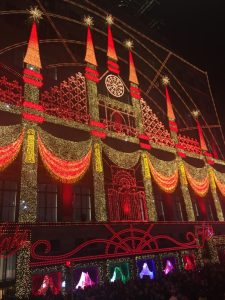In 1902, while still at Marshall Field’s, Harry Gordon Selfridge said to his staff: “Every day is show day in this establishment.” A few years earlier the effervescent Selfridge added the first show windows at Field’s. At the time, the Windy City’s iconic retailer sported the largest polished plate glass windows of any building in Chicago.
Retail was changing dramatically in the early days of the great “merchant princes” as the latest and greatest innovations and technologies were being enthusiastically embraced across the country. The great technologies of the day were cast iron, allowing for large expanses, and plate glass. Together, the two created the industry’s first show windows.
Previously, quality plate glass had to be imported from France. As the 19th century folded into the 20th century, American factories began churning out tremendous amounts of plate glass. Soon, America was consuming more than half of the plate glass produced worldwide. In New York, a walk down “Ladies Mile,” from 23rd Street to 14th Street, was like a walk through a crystal palace of glass, as show windows demarcated the early department stores along Sixth Avenue.
In Philadelphia, merchant John Wanamaker said, “Our minds are full of windows.” His first department stores in New York and Philadelphia had nearly 100 large show windows. He went on to say, “Show windows are eyes to meet eyes.”
Wanamaker and Selfridge, along with the likes of Henry Siegel and Hugh O’Neill, among many others, were creating a new paradigm for the retail industry, fueled by the technologies of the post-Industrial Revolution era. Selfridge counseled, “Learn to forget the past, and deal more with the present.” And while today’s retailers must embrace the future and all of its cutting-edge technologies, the essence of the past together with new innovation, is alive and well behind the sparkle of the window glass.
In the 1930s, industrial designer/store designer Norman Bel Geddes said, “The store window is a stage, and the merchandise, actors on the stage.”
Advertisement
Perhaps that’s why today, visual merchandising and the show window are more important than ever before as retailers across the industry search for ways to bring customers back into the stores. The language of visual merchandising and the drama and pizzazz of the show window are vibrant tools that resonate with today’s digitally savvy and social-media-conscious shoppers.
The fourth quarter is “make it or break it” time for retail. As the dog days of August begin to wane, and autumn’s chill cools the air, retailers would do well to dust off their thespian sensibilities. It’s the time of year when companies invest heavily as the curtain goes up for the November and December selling season.
As the spirits began to soar just before Thanksgiving, Fifth Avenue in New York was closed to vehicular traffic for about 15 minutes as Saks Fifth Avenue ushered in the holidays with a window unveiling that was nothing short of spectacular. To launch its “Theater of Dreams” promotion, the façade of the iconic building was aglow with digital mapping, flashing cameras and dynamic theatrics, including a live dance routine by more than 100 Broadway performers, as the retailer paid homage to Broadway and the most wonderful (and lucrative) time of the year.
On Lexington Avenue, Bloomingdale’s celebrated the Dr. Seuss classic, and Hollywood’s latest version, of “How the Grinch Stole Christmas,” with a bank of high-tech interactive windows that included a karaoke machine and a selfie camera for photo opps next to the Grinch. Bergdorf Goodman, as always, created a window extravaganza that would be the envy of any Broadway producer. In a celebration of confectionary delights, the window artists lavishly presented everything from gingerbread to candy canes.
From Macy’s and Louis Vuitton to Barneys and Tiffany’s, retailers are raising the curtain in show windows across retail’s great stage, drawing crowds of holiday revelers, traditionalists, cutting-edge creatives, and of course, shoppers to their decked halls and festive doors.
Eric Feigenbaum is a recognized leader in the visual merchandising and store design industries with both domestic and international design experience. He served as corporate director of visual merchandising for Stern’s Department Store, a division of Federated Department Stores, from 1986 to 1995. After Stern’s, he assumed the position of director of visual merchandising for WalkerGroup/CNI, an architectural design firm in New York City. Feigenbaum was also an adjunct professor of Store Design at the Fashion Institute of Technology and formerly served as the chair of the Visual Merchandising Department at LIM College (New York) from 2000 to 2015. In addition to being the Editorial Advisor/New York Editor of VMSD magazine, Eric is also a founding member of PAVE (A Partnership for Planning and Visual Education). Currently, he is also president and director of creative services for his own retail design company, Embrace Design.
Advertisement


 Photo Gallery3 days ago
Photo Gallery3 days ago
 Headlines1 week ago
Headlines1 week ago
 Sector Spotlight2 weeks ago
Sector Spotlight2 weeks ago
 Headlines1 week ago
Headlines1 week ago
 Headlines4 days ago
Headlines4 days ago
 Headlines2 weeks ago
Headlines2 weeks ago
 Designer Dozen1 week ago
Designer Dozen1 week ago
 Headlines2 days ago
Headlines2 days ago
















